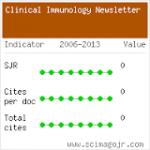Citation:
Ginsburg I, Lahav M. How are bacterial cells degraded by leukocytes in vivo? An enigma. Clinical Immunology Newsletter. 1983;4 (11) :147-153.

Abstract:
This year marks the centennial anniversary of Elie Metchnikoff's discovery of the pivotal role played by "professional" phagocytes in body defenses against invading microorganisms. His cellular theory dealt with the phagocytic events and the postphagocytic killing, and also alluded to the digestion of the internalized bacteria by the "cystases," later shown to be associated with the lysosomal apparatus of leukocytes. Fo date, despite the fact that numerous studies have described in great detail the mechanisms by which serum and leukocytes kill microorganisms (1, 8, 13, 24), surprisingly little is actually known about the biochemical pathways of degradation and mechanisms of disposal of microbial constituents once they have been sequestered within phagolysosomes (3, 9, 10, 13, 24). It is usually taken for granted that the numerous hydrolytic enzymes, including the key bacteriolytic enzyme lysozyme (muramidase), present in lysosomes of "professional" phagocytic cells [granulocytes or polymorphonuclear neutrophils (PMNs), and macrophages] are capable, (at least theoretically) of stripping off bacterial coats, thus exposing the peptidoglycan to cleavage by touramidase. Yet, the majority of pathogenic microorganisms are highly refractory to lysozyme action (9, 10, 17). One should also bear in mind that, while a massive breakdown of microbial cell walls eventually may lead to a bactericidal reaction, the mere killing of a microorganisms, either by leukocyte or by serum factors, may not necessarily be followed by a bacteriolytic reaction. The importance of elucidating the mechanism of microbial biodegradation in tissues stems from the observation that in many infectious diseases there is "storage" of nonbiodegraded microbial cell wall components within macrophages for long periods, which may be responsible for the perpetuation and propagation of chronic inflammatory sequelae and tissue destruction (10, 18). We have recently postulated (11, 14, 15) that bacteriolysis, and the biochemical degradation that ensues after bacteria have been attacked by serum or by leukocytes, may involve close cooperation among heat-stable serum factors, cationic proteins and phospholipase A2 of leukocytes, and heat-labile endogenous bacterial autolyric wall enzymes. This cooperation is affected markedly by anionic polyelectrolytes, likely to accumulate in inflammatory exudates, which may shut down autolysis and, thus, contribute to unfavorable postinfectious sequelae (10, 19). The present communication is a summary of efforts from our laboratory to gain insight into the mechanisms of lysis of Staphylococcus attreus, chosen as a model, by lysosomal enzymes of human blood leukocytes (3, 8-11, 14, 15, 19).Publication Global ID: http://www.sciencedirect.com/science/article/pii/S0197185983800508

